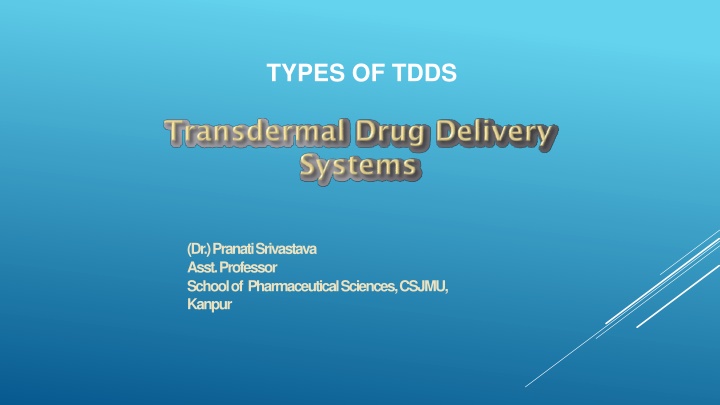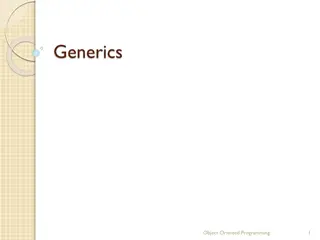
Advancements in Transdermal Drug Delivery Systems
Discover the latest technologies in transdermal drug delivery systems, including needle-free jet injectors, pain-free delivery methods, penetration enhancers, solvents used, and the use of ultrasound for enhanced skin permeability. Learn about the benefits of these innovations for improved efficacy, safety, and patient comfort.
Download Presentation

Please find below an Image/Link to download the presentation.
The content on the website is provided AS IS for your information and personal use only. It may not be sold, licensed, or shared on other websites without obtaining consent from the author. If you encounter any issues during the download, it is possible that the publisher has removed the file from their server.
You are allowed to download the files provided on this website for personal or commercial use, subject to the condition that they are used lawfully. All files are the property of their respective owners.
The content on the website is provided AS IS for your information and personal use only. It may not be sold, licensed, or shared on other websites without obtaining consent from the author.
E N D
Presentation Transcript
TYPES OF TDDS (Dr.) Pranati Srivastava Asst. Professor School of Pharmaceutical Sciences, CSJMU, Kanpur
Pain-free delivery particles are too small to trigger pain receptors on the skin. Improved efficacy and bioavailability. Targeting to a specific tissue, such as a vaccine delivered to epidermal cells. Accurate dosing and Overcomes needle phobia. Safety the device avoids skin damage or infection from needles or splash back of body fluids. The PowderJect system fires solid particles (20 100 m) through stratum corneum into lower skin layers, using a supersonic shock wave of helium gas. Intraject is a development of the vaccine gun designed to deliver liquids through skin without using needles.
Asubstance that will increase the permeability of the epithelial barrier by modifying its structure also termed as accelerants or sorption promoters-can enhance drug flux. Ideal Penetration Enhancer Non-toxic, non-irritating, non-allergenic. Immediate onset of increased permeability. Immediate recovery of normal barrier properties upon removal (reversible). Physically and Chemically compatible with a wide range of drugs.
Solvents - Ethanol, acetone, polyethylene glycol, glycerol, propylene glycol, dimethyl sulfoxide - Brij30, brij72, Pluronic, Sodium lauryl sulphate, Span 20, Tween 80. Surfactants Azones - N-Acyl hexahydro-2-oxo-1H-azepines, N-Alkylmorpholine-2,3-diones. Terpenes - Limonene, Carvone Fattyalcohols fatty acids - Lauryl alcohol, linolenyl alcohol, oleic and acid and lauric acid. Miscellaneous - Lecithin, sodium deoxycholate, L-amino acid, acid phosphatase,phospholipase & calonase
1.ULTRASOUND (PHONOPHORESIS / SONOPHORESIS) Used originally in physiotherapy and sports medicine, applies a preparation topically and massages the site with an ultrasound source. The ultrasonic energy (at low frequency) disturbs the lipid packing in stratum corneum by cavitation. Sonicators operating at frequencies in the range of 20kHz to 3MHz are available commercially and can be used for Sonophoresis. Therapeutic ultrasound (1 3MHz) Low-frequency ultrasound (23-40kHz) - in dentistry, High-frequency ultrasound (3 10 MHz) - diagnosticpurposes. - for massage,
The electrical driving of charged molecules into tissue, passes a small direct current (approximately 0.5 mA/cm2) through a drug containing electrode in contact with the skin. The most popular electrodes are based on the silver/silver chloride redox couple. Three main mechanisms enhance molecular transport: Charged species are driven primarily by electrical repulsion from the driving electrode. Flow of electric current may increase the permeability of skin and Electroosmosis may affect uncharged molecules and large polar peptides. Limitations: Hair follicle damage is possible.
Skin electroporation (electropermeabilization) creates transient aqueous pores in the lipid by application of high voltage of electrical pulses of approximately 100 1000 V/Cm for short time(milliseconds). These pores provide pathways for drug penetration that travel straight through the horny layer. This technology has been successfully used to enhance the skin permeability of molecules with differing lipophilicity and size including biopharmaceuticals with molecular weights greater that 7kDA..






















